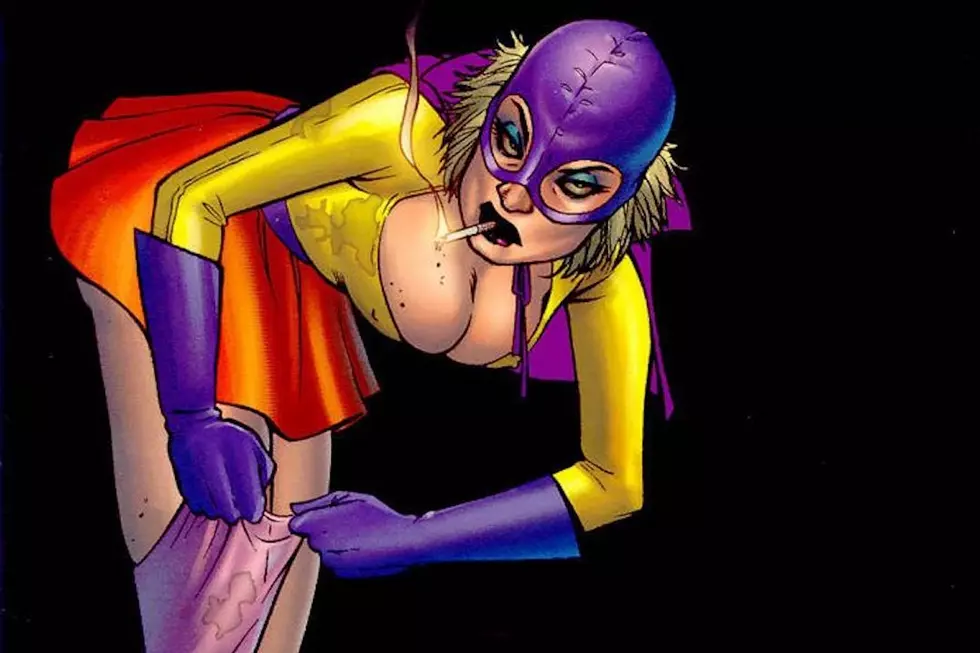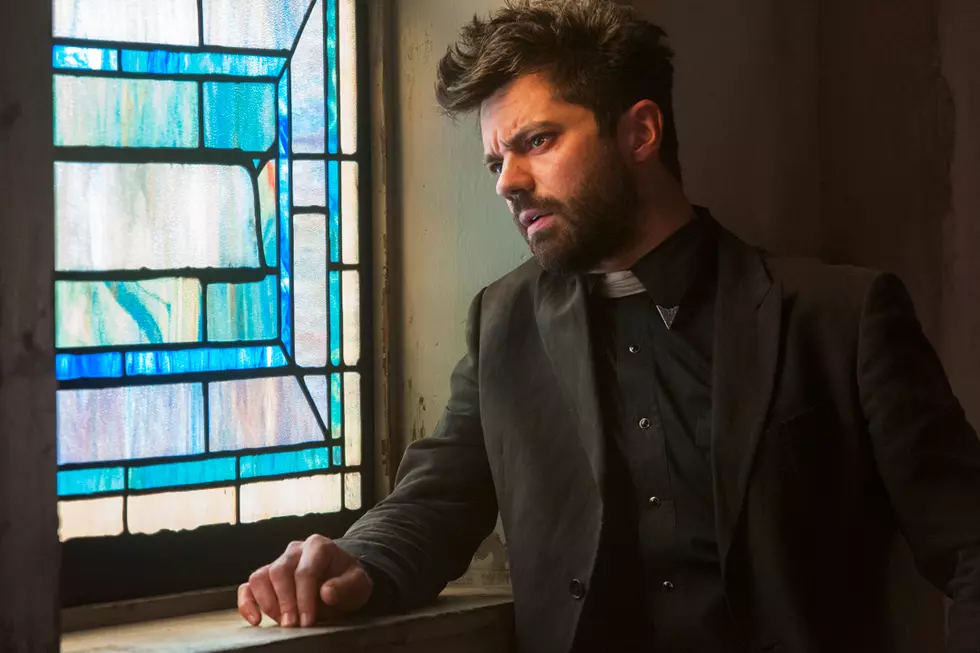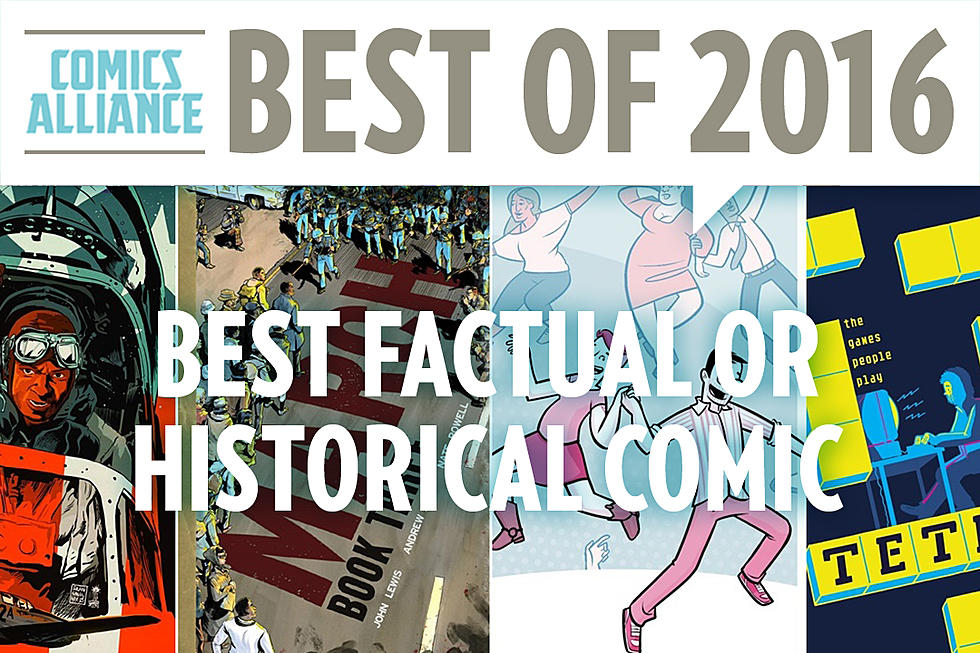
Preacher Ma’am: How Does ‘Dixie Fried’ Hold Up Today?
As someone who thought she was a dude in the late 1990s, Preacher was the comic I looked forward to every month more than any other. As someone who knows she isn’t a dude in the mid-2010s, I’m looking back on this series and examining what still works, what doesn’t work, and what its lasting legacy is.
In Dixie Fried the cast starts to settle into a routine, and one of the greatest strengths of the series comes to the fore, even as characters turn out to be not what they seem and the series’ perspective on religion turns out to be more nuanced than expected. Dixie Fried was written by Garth Ennis, drawn by Steve Dillon, and features colors by Matt Hollingsworth, Pamela Rambo, and James Sinclair, letters by Clem Robbins, and was edited by Axel Alonso.
Preacher has some of the best conversation-for-conversation’s-sake conversations in comics.
A lot of the hype for the series at the time was about its transgressive humor, and a lot of the best parts in retrospect are still the more dramatic twists, such as what happens with Cassidy and the ups and downs of Tulip’s relationship with Jesse. But what makes the series an old, familiar comfort to me are just the scenes with characters sitting down and having a chat about whatever’s on their mind, and this collection features some of the best examples of that.
It’s surprising how in flux the entire cast has been in these early story arcs, with book two writing out Cassidy for an entire arc, and book three having Jesse temporarily abandon Tulip due to his own misplaced machismo. The cast was always unstable, and the iconic photograph the series ends on was only ever one moment in time. But with this collection, the cast finally all gets together and is set to stick with each other --- just in time for it to all start to go to hell.
A word about the art (the colors, specifically) --- this is the collection where Pamela Rambo takes over for Matt Hollingsworth on color duties, which is also where the shift in artistic techniques on Steve Dillon’s part begins. Dillon starts to use fine shading and hatching less, and his figures become bolder and more stripped down, leaving said details to Rambo and James Sinclair’s color techniques. The transition is a little awkward, but pays some dividends, as Cassidy is slowly depicted with a less colorful and more sickly palette, underlining the reader’s realization that maybe he’s not the colorful charmer he thinks he is.
Dixie Fried starts off with one of my favorite single issues, Preacher #27, AKA "Gunchicks," as Tulip makes it clear she’s furious with Jesse for ditching her in Paris and goes off to meet with one of my favorite supporting characters, Amy.
Amy helps to showcase a different side of Tulip, and is welcome every time she shows up; she lets Tulip be a character who is into girly drinks and fancy dresses as well as rap music and a firearms collection that would make the Punisher blush. With her around, Tulip is brought into sharper relief as a woman who has more going on than being a sounding board for Jesse and Cassidy wrestling with their own masculinity.
Tulip and Amy catch up and meet up with a surprisingly drunk Cassidy, who confesses that he’s sweet on her, the first big hint that Cassidy has a darker side (and indeed may be mostly just that darker side.) He sobers up, apologizes, and begs Tulip to give him a second chance. She reluctantly agrees, and everyone begins to get comfortable with each other on the big road trip they’re on.
They decide that rather than go and hit up a Navajo or Hopi reservation, they’ll go visit a friend of Cassidy’s who’s into voodoo (or vodou, as it’s known in Haiti, and the spelling I’ll use in this article.)
What I know about vodou would barely fill up a sentence, so I can’t judge as to the accuracy (but it’s probably dubious), but what’s interesting about this is that it’s a more selective approach to disdain for religion than the more modern “they’re all fairy tales” approach. Vodou is treated in the narrative as real, and it makes sense --- God, the Devil, angels, demons, and a baby spirit that makes Jesse’s word balloons glow red are all real, so once that door’s open, anything goes.
What Ennis and Dillon have a problem with in regards to God and Christianity seems to relate solely to God and Christianity themselves, or how they’ve developed in modern society; it’s not the believer mindset they have a problem with so much as the authority structures of modern churches and the way God’s personality is depicted in scripture. This tracks with how the Grail is depicted; harmful because of the power it wields, regardless of it being wielded by a politician or a believer.
They’re sidetracked by Arseface, who last we saw was shaping up to be a parody of a supervillain, right down to vowing vengeance and taking on a new name in the midst of a crashing thunderstorm and lashing rain. But the parody takes an unexpected, more nuanced and sympathetic approach with Arseface, who is suddenly more than a fool or a villain once Jesse realizes he did Arseface a wrong turn.
What used to be plainly understood and a simple story of vengeance, blood repaying blood, is suddenly a little more complicated. I think this is why the comic stops translating for Arseface at this exact moment; a translation is meant to clarify, and things are suddenly less clear than the usual story of Jesse walloping a random fool crossing his path.
Ennis loves his fools, and Arseface is still ultimately a fool, destined to never become a more fully formed character until the TV series comes along. But the theme with his character is mirrored by Cassidy’s; just as things with this supposed goofball villain turn out to be more complicated than at first blush, so too does everything to do with Cassidy.
Prior to this story there were hints that Cassidy had a shady past, but that it was the kind of shady past that heroes and anti-heroes in fiction have; a few regrets that can be set right, a few bits of untidy business, maybe someone got cheated out of the Millennium Falcon at cards (a direct reference made by Jesse.) The kind of “little bit bad but not too bad” background the archetypal rogue has.
After this story, though, that has all but slipped away, and it’s obvious that Cassidy is what a person with an actual shady past and a deeply irresponsible view of life would be. The synonym of “carefree” is “careless,” after all --- even though they feel like different words, they're not that far apart.
There’s very little hint of this in the one-shot that rounds out the collection, Blood and Whiskey, but it is one of the best of the more comedic one-shots, having a back-in-the-day Cassidy run into another vampire who looked at Lestat and thought, “Well, I can top that.” There’s a few jokes that can stay on the shelf (fat-shaming being the biggie) but the main running joke --- having Cassidy’s foil be someone who takes being a vampire way too seriously --- is a perfect idea, since Cassidy if anything doesn’t take his power seriously enough. If Blood and Whiskey hadn’t been written, Preacher would feel incomplete.
One final note is that this is the collection where Garth Ennis and Steve Dillon, dressed in perfect Jesse Custer and Cassidy costumes, turn to the reader and say, “Hey, you know who’s a real good comedian? Bill Hicks. You should get into him.”
I’m not saying that the out-of-nowhere revelation that Jesse Custer was heavily into Bill Hicks caused me to go out and buy every comedy album of his that I could find; I’m just saying that we were all in our early twenties once. But it’s a fitting segue for two reasons.
First, Preacher and Bill Hicks were peas in a pod in some ways, with a social conscience informed by the mythos of America and the cowboy, and immaculate comic timing telling jokes that haven’t all aged well --- along with a streak of anti-authoritarianism that, in an age where too many institutions seem committed to spectacular failure, is as relevant as ever, with all that craft and heart sadly dragged down by its choice of dated comedic material.
The second is how it sets up what truly angers Jesse Custer --- dishonesty, both to others and to oneself --- and brings into relief how much Cassidy and Jesse are alike even as they’re destined to come to blows. Cassidy thinks humanity isn’t worth it; “a virus with shoes,” to quote Hicks, and Jesse thinks that the preponderance of the worst in us is all the more reason to fight for what’s best. To be one of the good guys, on account of there being too many of the bad. They both agree to disagree, and they both love Bill Hicks --- because they both see a lot of themselves in him, and in each other.
It all comes to a head as an old villain returns, Jesse meets the Saint once more, and Ennis and Dillon follow through on the most hoary, overused comics cliché of Nothing Will Be the Same Again.
All in two weeks’ time. See you then.
Special thanks to David Lebovitz at Deadshirt for his insights!
More From ComicsAlliance



![NECA Pits Aliens Against Batman, Turtles Against Terminators And More [Toy Fair 2017]](http://townsquare.media/site/622/files/2017/02/IMG_2656.jpg?w=980&q=75)





